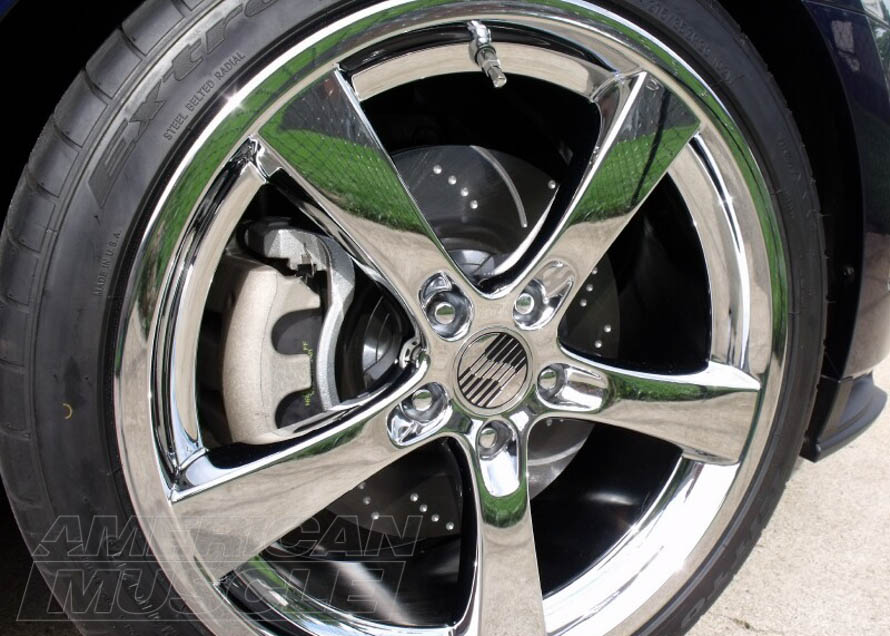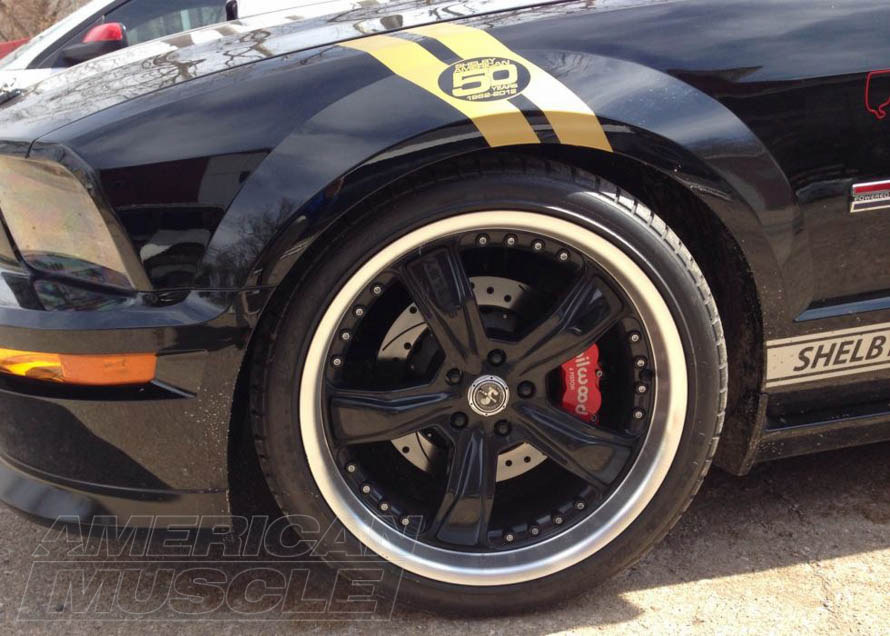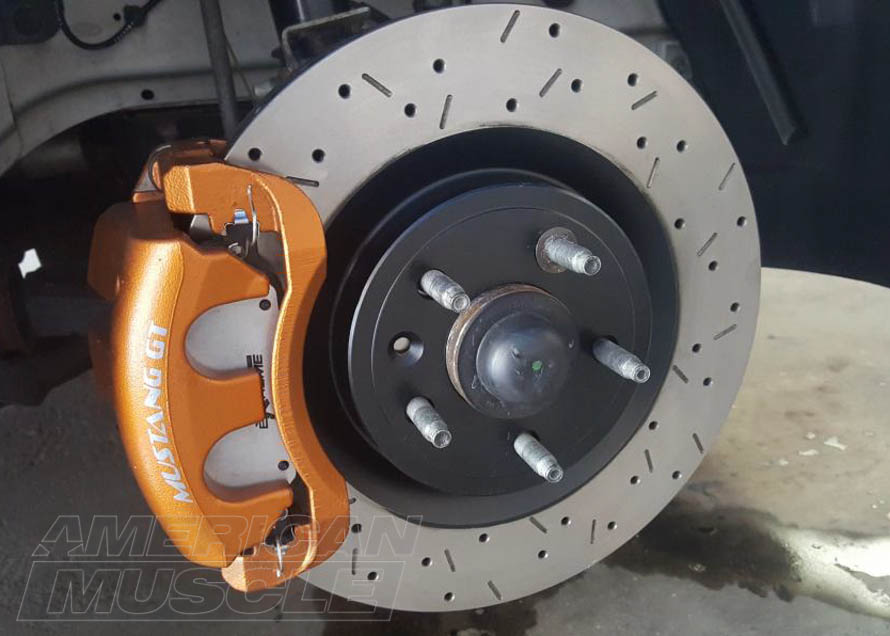Reigning in the power of your Mustang can be no easy task. Even the S550 EcoBoost Mustang is putting down a whopping 310+ HP, which can get even the most restrained of enthusiasts into trouble. Swapping out the brake pads on your Mustang is one of the simplest ways to improve your braking performance for a small amount of money.
Shop Mustang Brake Pads
Aftermarket brake pads are the easiest ay to improve your Mustang's stopping ability and overall safety. Select a set of pads from one of the top manufacturers and enjoy the benefits of a more responsive braking system.
Shop Brake Pads
How a Mustang's Brake Pads Works
Brake pads work by removing energy from your Mustang via the friction they create when forced against the brake rotor. Friction causes heat and the longer the friction is endured, the more heat is created. To solve this, some pads are designed to run very hot before losing their friction coefficient.
However, no brake pad can perform at the best level in all situations. The following section details things you should consider to help you pick the best brake pad for your type of driving.
Stock Mustang Brake Pads
The stock brake pads on your Mustang can do an alright job when the rest of your car is stock, but the more you mod the suspension or the powertrain, you quickly outgrow the capabilities of the stock brakes. Even though the stock pads are fine for non-modded daily drivers, if you do any sort of track driving with your Mustang or push it beyond its factory specifications, you can be left wanting/needing more out of your braking performance. Even the S197 and S550 Mustangs that were offered with Brembo brakes can use a better pad if you upgrade your pony at all.
How Easy Is It To Install Mustang Brake Pads?
Upgrading the brake pads on your Mustang is an easy two hour job at max, but really can be knocked out in as little as 30 minutes (if it isn’t your first rodeo). To upgrade your Mustang’s brake pads you need to:
- Jack up your Mustang off the ground
- Remove the wheels
- Remove the bolts holding the calipers in place
- Turn back the screw/spring for the pads that keeps them close to the rotor (this is best completed with the special key tool)
- Put the new pads in place
- Put all the parts you removed back on
- Ensure the pedal feel is firm and brakes work properly
Going with a set of aftermarket brake pads is one of the easiest and most rewarding mods. It can be relatively cheap to get new pads, the work can easily be done yourself (regardless of your mechanical background or expertise) and it will give you a solid performance return on your modding investment.
How Should I Improve My Mustang's Braking After Replacing the Pads?
A brake pad upgrade can make a world of difference at track or on the street and is a good foundation to building up your whole braking system. Once you’ve become accustomed to the improved bite of a set of aftermarket brake pads, you will want to consider upgrading the rotors. After the rotors have been replaced, upgrading the brake lines will give you even more aggressive braking. Changing out the DOT braking fluid for a higher rated fluid will also help to increase braking performance and reduce on brake fad.
Ceramic Brake Pad Review and Installation
What to Consider When Buying Brake Pads for a Mustang
It is easy to get overwhelmed by all of the different brake pad options on the market for Mustangs. There are countless options and all of them offer something a little bit different. As an enthusiast, you’ll want to consider a few questions to ponder as you shop for pads, and may want to even talk to other Mustang owners who upgraded their brake pads for their input.
When you are shopping for a set of aftermarket Mustang brake pads, you’ll want to consider the following:
- Brake Fade – Brake fade is a common problem that can plague any vehicle, especially one being pushed to its limits on the track. The more your push your Mustang and exercise the brakes, the more they will succumb to the heat being generated by the friction causing reduced performance which can lead to failure. Be sure to ask others or look on product pages for information on how the pads in question respond to brake fade
- Noise – Brakes can be noisy, especially when they get hot or worn. We are all familiar with that squeaking brake sound. A good set of brake pads will not make a lot of noise unless they are putting off a good bit of heat. Typically, ceramic pads tend to be quieter, but it will ultimately come down to the manufacturer
- Brake Dust – Pads are a wear and tear item that need to be replaced on a semi-regular basis as they get whittled down every time you step on the brake pedal. Brake dust is created as a result of abrasive friction between the brake pad and the rotor which wears both the rotor and pad away. There have been claims that brake dust can damage the finish of most wheels if not washed off. Generally, a brake pad that aggressively abrades more rotor material, such as metallic pads, will create more brake dust. Depending on the manufacturer, some pads will offer less brake dust than others
Mustang Brake Pad Material: Ceramic vs Graphite
Brake pads are made from a limited number of materials, as there are only a few materials that can withstand such heat and abuse while being not being too offensive or brash for driving conditions. Most brake pads are made from either graphite of ceramic (with a few composite options floating around), as they both can withstand high heat ranges and repeated use.
The most commonly preferred material is ceramic as they generally produce less noise and dust while simultaneously performing flawlessly. Most stock pads are a metallic blend that can encompass several different metals, leaving you with a good bit of dust and something that won’t standup to repeated abuse.
Mustang Brake Pad Sizing
The size of a brake pad matters only in terms of heat capacity and wear rate. A larger pad can absorb more initial heat and have better wear characteristics, resulting in longer pad life. If you can’t afford a larger big brake kit that increases the rotor size and offers more caliper pistons, then you can get the next best thing and get a high performance brake pad.
If you have two brake pads made of the same compound, the larger pad will not in itself give you a shorter stopping distance. The caliper piston pressure, the pad’s friction coefficient and the amount of rotor that the pressure is applied to are all factors in overall stopping distance. A larger pad in itself does not apply more pressure; it only touches a greater surface area.
How Do I Know When To Replace My Mustang’s Brake Pads
You should replace your Mustang’s brake pads if:
- There is less than ¼” of pad remaining (a few millimeters)
- You can hear a squealing/squeaking when you hit the brakes
- You’re brakes feel like they are not performing as well
- The car feels like it is pulling to one side when braking
If you continue to use your pads down to the very end and go past the point where they need to be replaced, you can begin to cut into your rotors, scoring them with the pads. If this happens, you will need to replace both the rotors and the pads, as the rotors cannot be resurfaced if they become scored.
Fitment includes: 1979, 1980, 1981, 1982, 1983, 1984, 1985, 1986, 1987, 1988, 1989, 1990, 1991, 1992, 1993, 1994, 1995, 1996, 1997, 1998, 1999, 2000, 2001, 2002, 2003, 2004, 2005, 2006, 2007, 2008, 2009, 2010, 2011, 2012, 2013, 2014, 2015, 2016, 2017, 2018, 2019, GT, V6, Cobra, ShelbyGT500, Mach1, Bullitt, Boss, LX, SVO, EcoBoost, ShelbyGT350




